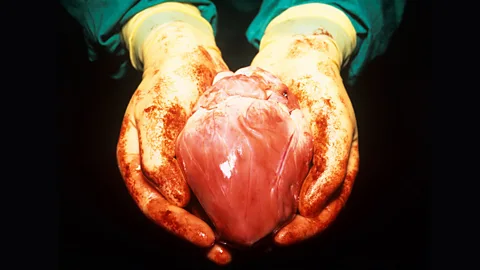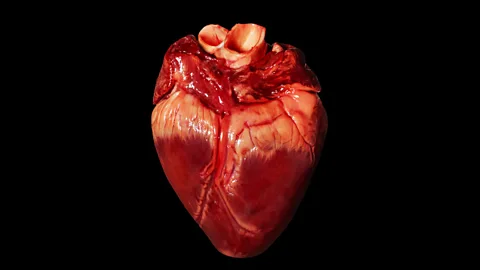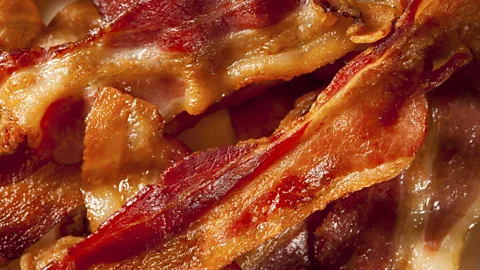Would you accept a pig’s heart?

If animal organs could be used to save our lives, will it mean we become a bit less human? Frank Swain speculates
Imagine that your heart is failing. You desperately need a replacement. Every day, your family waits nervously for a call from the hospital to say they’ve found a donor. Then one day, the call comes through. In your excitement you barely hear what the doctor on the other end of the line is telling you. There’s something you should know, she says. The donor is not human. It’s a pig.
That possibility crept a little closer last week, with the announcement that a pig’s heart had survived over a year after it was transplanted to a baboon. The work, led by Dr Muhammad Mohuiddin at the US National Heart, Lung and Blood Institute in Bethesda, Maryland, supports the case of those who say that animal organs could be used to help humans on long transplant waiting lists.
Such procedures would raise all sorts of thorny issues about what it will mean to be fully human in the future. If we can transplant pig hearts, then what other parts could we use to augment our bodies? And will taking non-human organs transform our relationship with animals, and even each other?

Xenotransplantation – using animal tissues in humans – dates back to at least 1682, when Dutch surgeon Job Janszoon van Meekeren reported that a Russian soldier’s skull had been repaired with a fragment of bone from a dog. Horrified church authorities ordered the removal of the graft, but it had healed too well to be removed. Later, Alexis Carrel’s pioneering techniques for suturing blood vessels paved the way for the first xenotransplanted organs in 1902, but it took until the 1960s for any meaningful progress, when surgeons had limited success transplanting primate organs to humans. However most failed within couple of months, and the patients died.
Today, however, primates are no longer considered viable donors, due to issues such as disease transmission risk and the ethical considerations of primate research. What’s more, the body would probably reject the organs. “The major obstruction to xenotransplantation was the immunological rejection,” says Mohuiddin.
Pigs, however, have proven to be better donors, at least in tests on baboons. A pig’s heart is anatomically similar to a human, they pose less of a disease risk and the animals grow quickly, making them an excellent substitute. Crucially, by modifying a pig’s genetics, Mohuiddin was able to render the transplanted hearts invisible to the baboon’s immune system. Two genetic tweaks reduced the ability of the baboon’s immune cells to identify the heart as a foreign body. A third added a gene that produces a human anti-clotting agent to help counter immune system reactions that can be triggered by blood clots forming around foreign tissue. Together, these changes allowed the heart to survive far longer than previous attempts.

So, what would a world with animal organ transplants in humans look like? Might we one day see farmers in overalls mucking out pens where pigs roll in the hay and oink happily as they grow a stock of organs inside them? Perhaps that doesn’t seem too different from the situation we have now. We have after all been rearing pigs for their meat for thousands of years, and transplantable pig hearts will probably sell for a good deal more than they currently fetches as offal.
Indeed, a ready supply of compatible organs might open up unexpected demand for animal products. Medical interventions – even very extreme ones – have a habit of normalising once the costs and risks fall. Who would have thought that life-saving blood transfusions might one day be used by athletes to gain an edge on their competitors, or that surgery to repair the faces of disfigured soldiers would find its home in the opulent clinics of Beverly Hills, shoring up the faces of wealthy clients against wrinkles and sunspots?
While we can only speculate, breaking down the biological barriers that separate us from the beasts could lead to all kinds of elective procedures. As I wrote last month, many people already covet ‘animal powers’, which they aim to acquire via technology. Eventually, we might opt for cosmetic changes, and attach the oversized canines of wild animals to our teeth like the cyberpunks of William Gibson’s novel Neuromancer. Alternatively, an athlete looking for a boost could switch her heart for something bigger, stronger, indefatigable – and maybe switch back again once her competitive days were over.

What is perhaps more interesting to ask is whether elevating the humble porker to life-saving superhero will change people’s relationship with the animal they are more used to seeing on their plates. Would you hesitate to sit down to a Sunday roast, knowing the pork on the table had the same heart beating in its chest as your great uncle? I put that question to Mohuiddin, but he declined to speculate on the issue.
Nonetheless, genetically augmenting pigs to make them more suitable as organ donors marks a small but important nudge toward them occupying some middle ground between food and friend. By expressing some of our genes, these pigs are, after all, very slightly human, and will become incrementally more so as the genes which present incompatibility issues are identified and swapped for human-tolerant ones.
Perhaps one day we’ll even go so far as to breed personalised pets that complement you perfectly, should you find yourself in sudden need of a heart, a kidney, or a liver. This ought to trouble our ethics far less than attempts to conceive a ‘saviour sibling’ – a child born in order to provide life-saving tissue donations to a desperately ill brother or sister.
Breeding the flesh of an animal to replace life-giving organs will undeniably change what these creatures are to us, and what it means to be ‘fully’ human. You only have to listen to your own heart beating in your chest right now to understand why.
